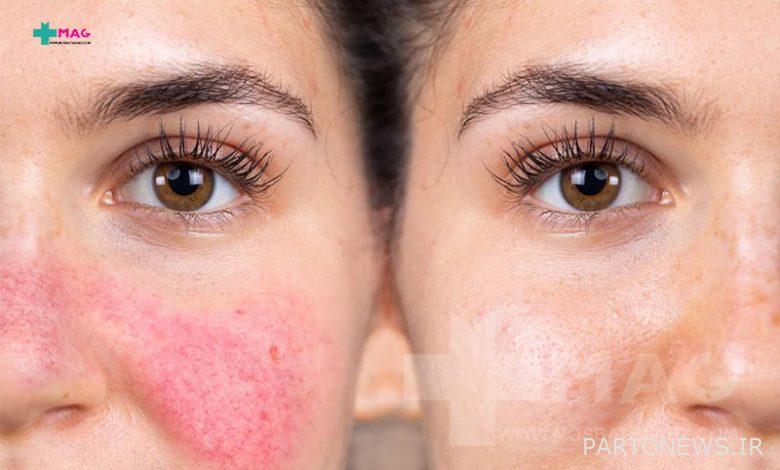The cause of skin redness and its treatment

Redness of the skin does not have only one reason. Sunburn, allergic reactions, infections and some diseases such as seborrheic dermatitis can be the causes of red skin. If the redness of the skin is not treated, the skin color may darken and become more unpleasant. In addition, the lack of some vitamins can make the skin more sensitive to sunlight and cause symptoms such as redness. Have you ever used a multivitamin to keep your skin healthy?
Sunburn is one of the most important causes of skin redness
Fortunately, this type of skin redness is temporary and usually heals easily. Being under the sun for a long time and not using sunscreen is the cause of sunburn. When you go out in the sun without sunscreen, the ultraviolet (UV) rays damage the skin and cause the body to direct more blood to the damaged area for repair. Redness of the skin due to sunburn may lead to itching, blistering and peeling of the skin.
Other types of skin burns
Skin burns can happen for other reasons besides sunburn. Including:
- Thermal burn: occurs when the skin comes into contact with a hot object such as an iron or hot liquids.
- Chemical burns due to the use of acidic detergents and…
- Electrical burns due to exposure to strong electric current
- Abrasion of the skin to an uneven surface
- Exposure to radiation (such as radiation therapy for cancer)
Any of the above burns can cause skin redness.
Dermatitis or eczema
Dermatitis or eczema is a type of inflammatory skin disease. In this disease, red and itchy spots are usually caused by inflammation. The most common types of dermatitis are:
- Contact dermatitis
- Atopic dermatitis (most common in children)
- Seborrheic dermatitis (usually occurs on the scalp)

In addition to skin redness, dermatitis can cause blisters, hives, swelling, dryness, scaling, and skin discoloration.
There is no definitive treatment for eczema. Changes in lifestyle, use of special moisturizers, and some over-the-counter medications topically or orally can be effective in improving eczema.
folliculitis
Folliculitis is a common condition in which the hair follicles in the skin become inflamed. A bacterial or fungal infection is the cause of this problem. In folliculitis, red bumps can be seen around the damaged follicle, which may be accompanied by itching. Purulent blisters may also appear in this area of the skin.
Folliculitis usually resolves on its own. In cases where the inflammation becomes painful, the doctor may use topical antibiotics or pain relievers such as acetaminophen.
rosacea
Another common cause of skin redness is rosacea. Rosacea causes long-term redness of the skin and often occurs in the face. This disease usually starts with hot flashes. As rosacea progresses, the hot flashes become longer and longer. Other symptoms of rosacea include spotting and burning sensation in the relevant area.

Treatment of facial skin redness
In order to treat rosacea, antibiotics such as tetracycline or erythromycin are often used. These drugs should be taken for 4 to 6 weeks, but sometimes longer treatments are needed. Also, the person should use topical creams prescribed by the doctor to help recovery.
Psoriasis
Related posts
Psoriasis is a long-term disease that causes excessive production of skin cells, resulting in red and dry patches and scaling with silvery scales. These spots mostly appear on the elbows, knees, or scalp, but they may also appear on other parts of the body. Psoriasis symptoms often come and go in cycles.
The first treatment used for psoriasis is topical treatments such as topical corticosteroids. Topical treatments are creams and ointments that are used on the skin. If local treatments are not effective, phototherapy may be used.
Shingles
Shingles is a viral infection that causes redness of the skin and a red rash with blisters. Symptoms of shingles can be seen in any part of the body. Among other things, it can also involve the face and eyes. Shingles usually starts with a burning and tingling sensation and can sometimes be very painful. Shingles often occurs only on one side of the body and is accompanied by blisters. Only people who have had chicken pox can get shingles.

Antiviral drugs such as acyclovir, valacyclovir and famciclovir are used to treat shingles and reduce the length and severity of this disease. These medications can be effective if used as soon as possible after the rash appears.
Lupus
Lupus is a chronic disease in which the body’s immune system mistakenly attacks organs and tissues. This condition can affect any part of the body. Some people with lupus develop rashes on the face, neck, and scalp. In this case, redness and swelling of the skin can be seen.
Lupus treatment depends on the individual’s symptoms and signs. The dose of drugs should be increased or decreased depending on the decrease or increase of symptoms. Medications often used to treat lupus include nonsteroidal anti-inflammatory drugs, antimalarial drugs, corticosteroids, and immunosuppressive drugs.

Allergy to some drugs
Some people may experience allergic reactions and skin redness after taking some medicines. For example, after taking penicillin and other antibiotics, epilepsy drugs, non-steroidal anti-inflammatory drugs such as aspirin and ibuprofen, and chemotherapy drugs. Allergies to medications can cause skin rashes, hives, itching, and swelling of the skin.
In severe cases, drug sensitivity may cause anaphylaxis, which is life-threatening and may lead to death. Symptoms of anaphylaxis include difficulty breathing, dizziness, rapid heartbeat, confusion, and loss of consciousness.
cellulite
Cellulitis is a skin infection that may worsen if left untreated. This condition occurs when bacteria infect the deep layers of the skin and cause redness, swelling, and heat and sensitivity to touch. Cellulitis can be accompanied by fever and chills, fatigue, cold sweats, nausea, drowsiness, and difficulty concentrating.
If cellulitis is not treated in time, it may lead to blood infection. Antibiotics are needed to treat cellulitis. If the infection is in the leg or hand, keeping this limb elevated can be effective in reducing swelling and speeding up recovery. In any case, medicine must be taken under the supervision of a doctor to treat cellulite.
Crimson
Scarlet fever can be one of the causes of skin redness. Scarlet fever is a contagious bacterial infection that usually occurs in children and infants. The infection causes a reddish-pink rash that is usually rough. Rashes usually first appear on the chest and then spread. Other symptoms of scarlet fever include: fever, sore throat, change in color and texture of the tongue, headache, muscle pain, nausea and vomiting, and abdominal pain.
A 10-day course of antibiotics is usually prescribed to treat scarlet fever. It may be from penicillin or Amoxicillin to be used.
In which case should we go to the doctor for redness of the skin?
You don’t always need to see a doctor to treat skin redness. For example, if you have a sunburn, you can help solve this problem by using topical creams and drinking plenty of fluids. First, the cause of the redness of the skin should be identified and then treated. In these cases, see a doctor after observing skin redness:
- If the rash does not go away after a few days.
- Rashes have affected large areas of the skin.
- The person has a fever.
- The rash appears suddenly and spreads quickly.
- The rash starts to blister and is painful.
- There are signs of infection.
In these cases, you must see a doctor. Also, if you have any questions about skin redness, ask our experts at Positive Green in the comments section.
Please rate this article
[مجموع: ۱ میانگین: ۵]

